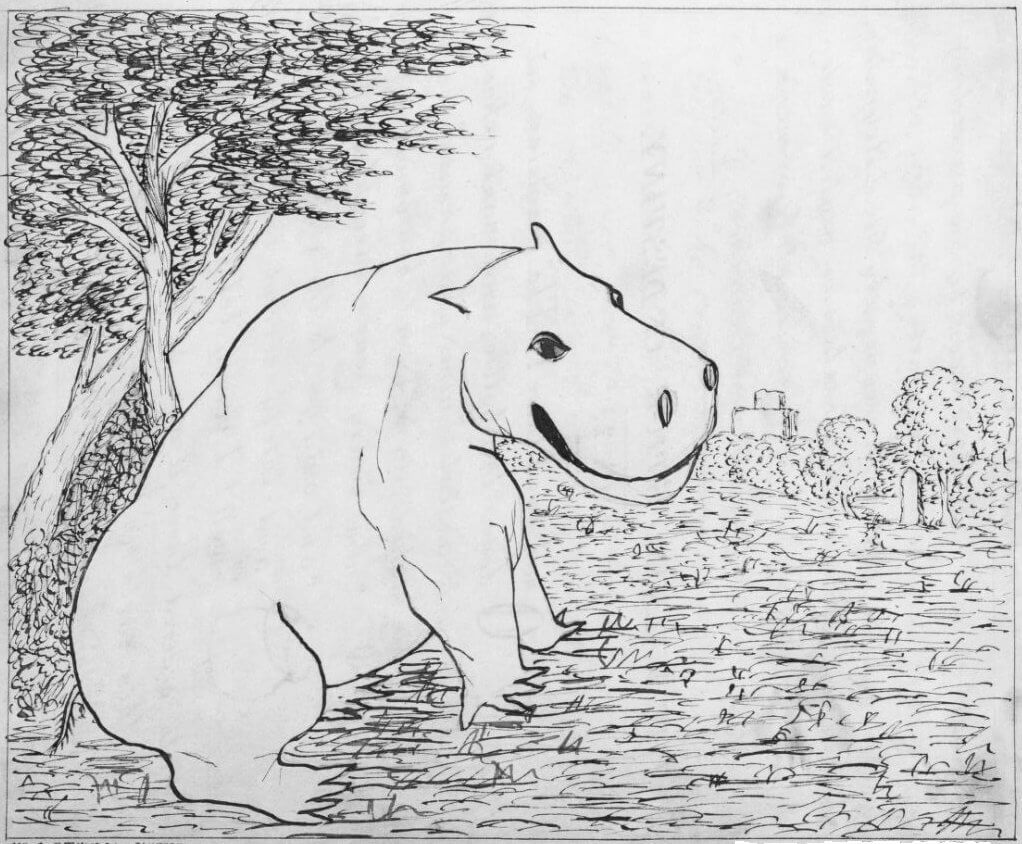
The Age of Innocence.
from the picture in the Vernom Gallery.
As our readers will have seen by the preceding page, we have commenced engraving the above series of pictures. “The Age of Innocence,” by Sir J. Reynolds, representing a young Hippopotamus seated under a shady tree, presents to the contemplative mind a charming union of youth and innocence.
Editor.
“The Scanty Meal”
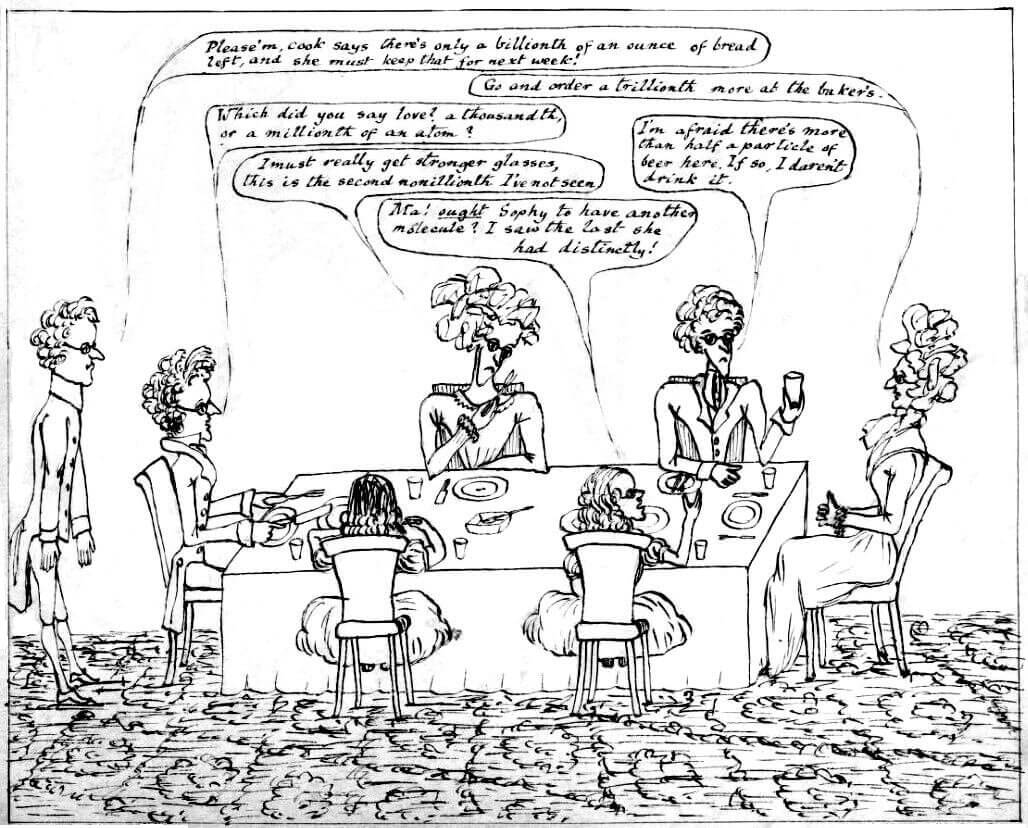
Please’m, cook says there’s only a billionth of an ounce of bread left, and she must keep that for next week!
Go and order a trillionth more at the baker’s.
Which did you say love? a thousandth, or a millionth of an atom?
I’m afraid there’s more than half a particle of beer here. If so, I daren’t drink it.
I must really get stronger glasses, this is the second nonillionth I’ve not seen.
Ma! ought Sophy to have another molecule? I saw the last she had distinctly!
The Scanty Meal.
from the picture in the Vernom Gallery.
We have been unusually1 successful in our second engraving from the Vernon Gallery. The picture is intended, as our readers will perceive, to illustrate the evils of homœopathy.2 This idea is well carried out through the whole picture. The thin old lady at the head of the table is in the painter’s best style: we almost fancy we can trace in the eye of the other lady a lurking suspicion that her glasses are not really in fault, and that the old gentleman has helped her to nothing instead of a nonillionth.3 Her companion has evidently got an empty glass in his hand: the two children in front are admirably managed, and there is a sly smile on the footman’s face, as if he thoroughly enjoyed either the bad news he is bringing, or the wrath of his mistress. The carpet is executed with that elaborate care for which Mr Herring is so famed, and the picture on the whole is one of his best.
“The Woodland Gait”
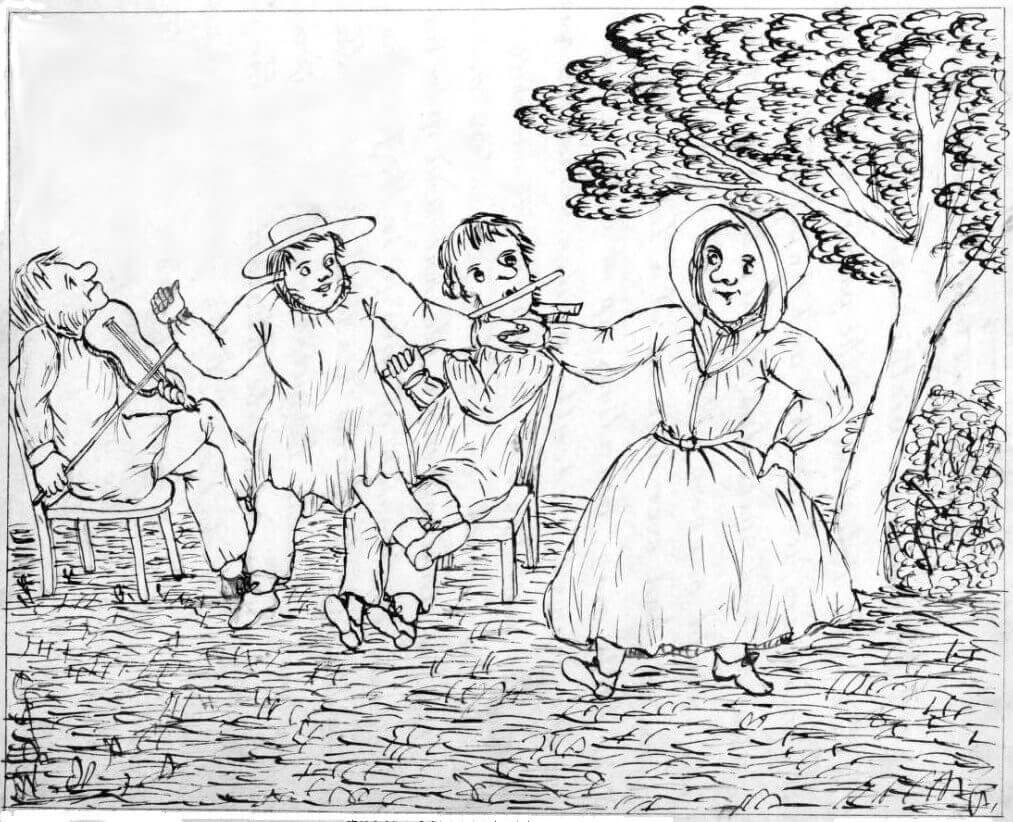
The Woodland Gait.
from the picture in the Vernom Gallery.
This charming picture represents a country dance: the intention of the painter is to pourtray rustic manners, untaught and unpolished; in this aim he has succeeded admirably, for surely no one would suppose either of the couple in the foreground had ever figured at a London ball.
The little man, bounding up at least a foot from the ground, evidently prides himself a good deal on his agility, but his partner, if one may judge by the smirk on her face, considers her own style of dancing more elegant and graceful. There is an expression of energy in the fiddler’s face as though he threw his whole life into the fiddle bow, and the languishing flute-player is evidently some would-be Mozart,4 whom the bad taste and bad ear of his unmusical neighbours has hitherto prevented from rising into celebrity. The rustic gait of all the four figures is, in our opinion, admirably depicted.
“The First Earring”
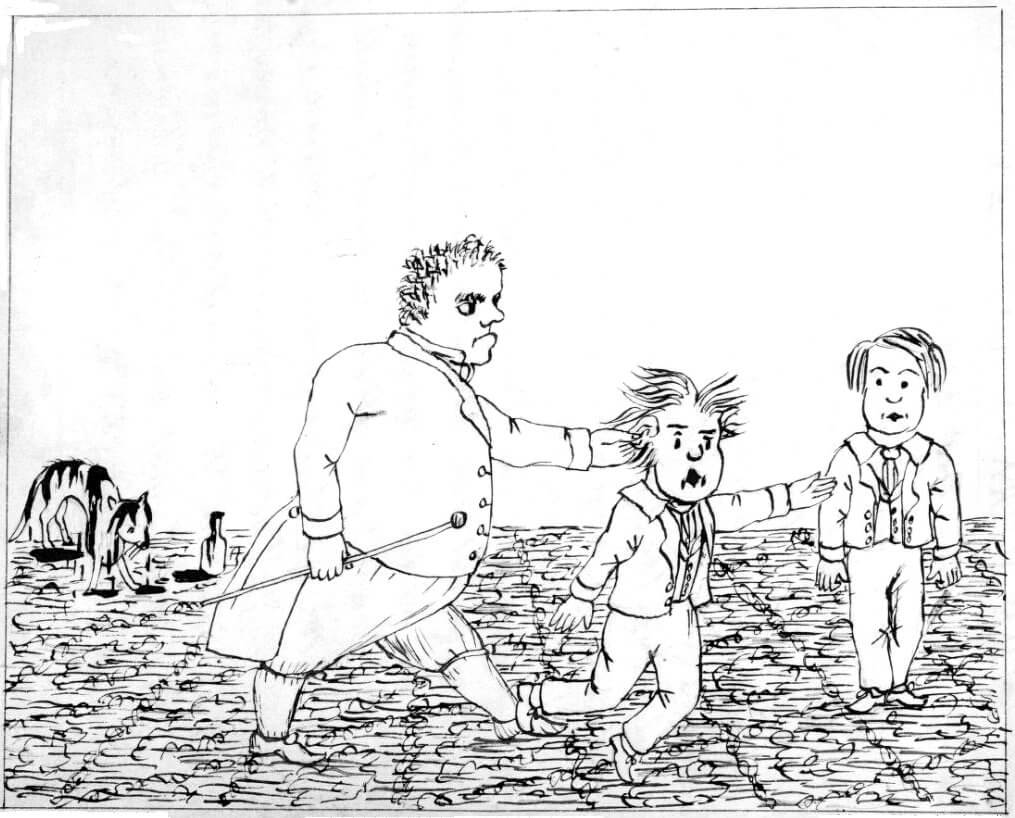
The First Earring.
from the picture in the Vernom Gallery.
The scene from which this excellent picture is painted is taken from a passage in the autobiography5 of the celebrated Sir William Smith6 of his life when a schoolboy: we transcribe the passage: “One day Bill Tomkins7 and I were left alone in the house, the old doctor being out: after playing a number of pranks Bill laid me a bet of sixpence that I wouldn’t pour a bottle of ink over the Doctor’s cat. I did it, but at that moment old Muggles came home, and caught me by the ear as I attempted to run away. My sensation at the moment I shall never forget: on that occasion I received my first earring.8 The only remark Bill made to me, as he paid me the money afterwards was, “I say, didn’t you just howl jolly!”” The engraving is an excellent copy of the picture.
“The Wooden Bridge”
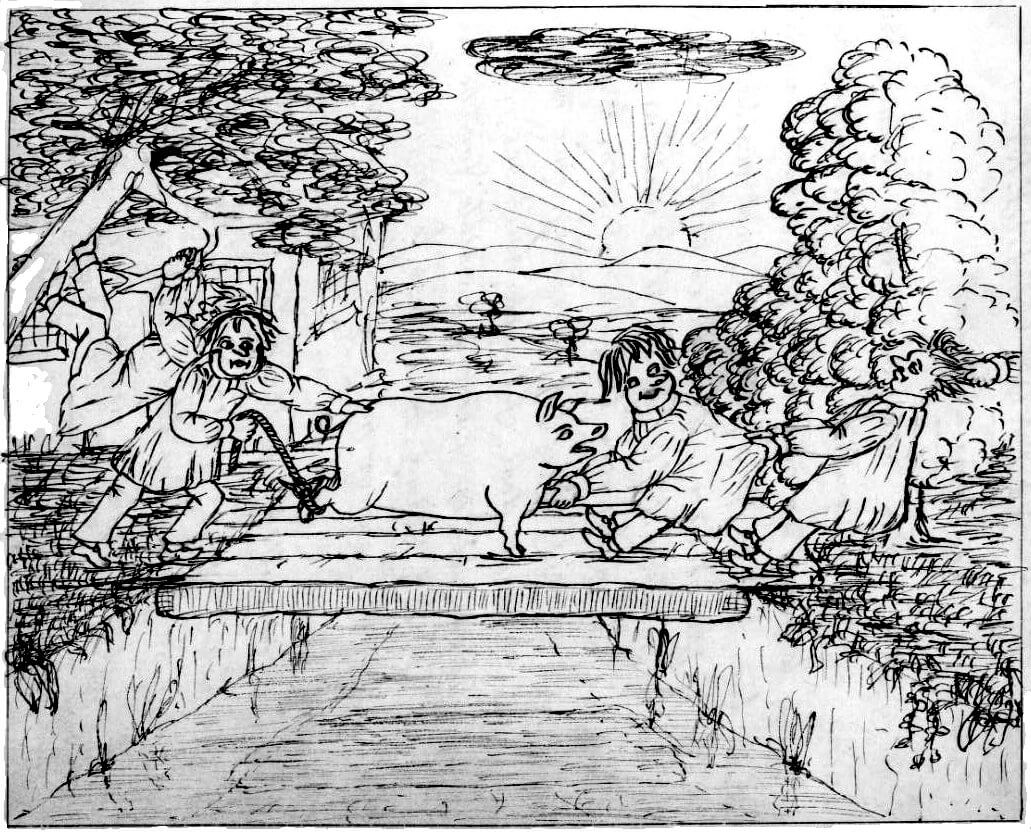
The Wooden Bridge.
from the picture in the Vernom Gallery.
A very few words will suffice to explain the meaning of this charming picture. Four ploughboys are trying to force an obstinate pig across a wooden bridge: the hands of a fifth are just visible at the edge of the picture. It appears either the height of cruelty or insanity to expect it to walk9 across on one leg. This however they do not seem to have sufficiently considered, and the consequence is they are taking a great deal of trouble with scarcely a hope of success. It is scarcely possible for the unhappy creature to stand, much less to progress a single inch, until one or more of its legs are released. The fourth figure appears as if he would prefer no help at all in pulling to the help he is receiving.10 The one who is pushing is evidently much of the same opinion. The trees, the cottage, and the setting sun in the background produce a fine effect.
“High Life and Low Life”
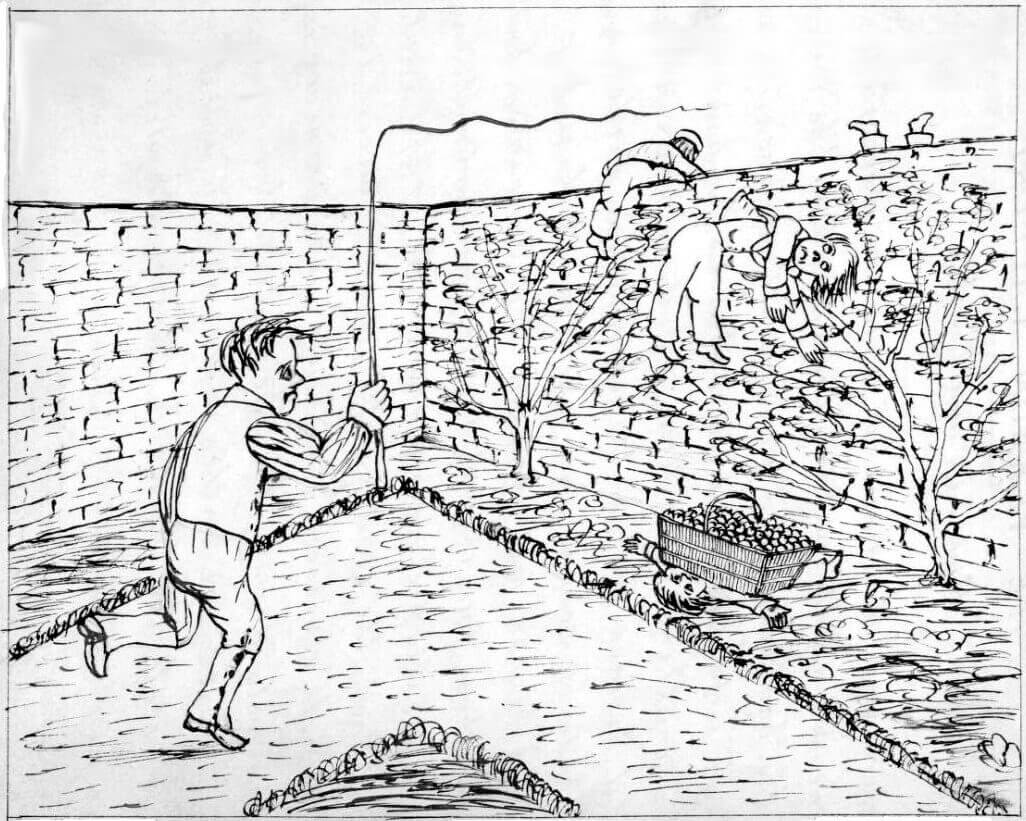
High Life and Low Life.
from the picture in the Vernom Gallery.
Never was the name of a picture more fully borne out in the picture than in this. The face of the boy suspended on the wall, representing “High Life,” is positively exquisite11: we have rarely seen anything more true to nature. One can trace in it, besides fear of the approaching gardener, a shade of sorrow and regret for the basket of apples12 he has just dropped. His companion however, whose face is just visible from under the basket, probably feels more real sorrow for that event. This last, the reader will of course perceive, is meant to represent “Low Life.” The gardener is admirably drawn, but the potatoe beds and gravel walk are rather inferior to the artist’s usual style. On the whole, however, the picture does him great credit.
“The Duett”
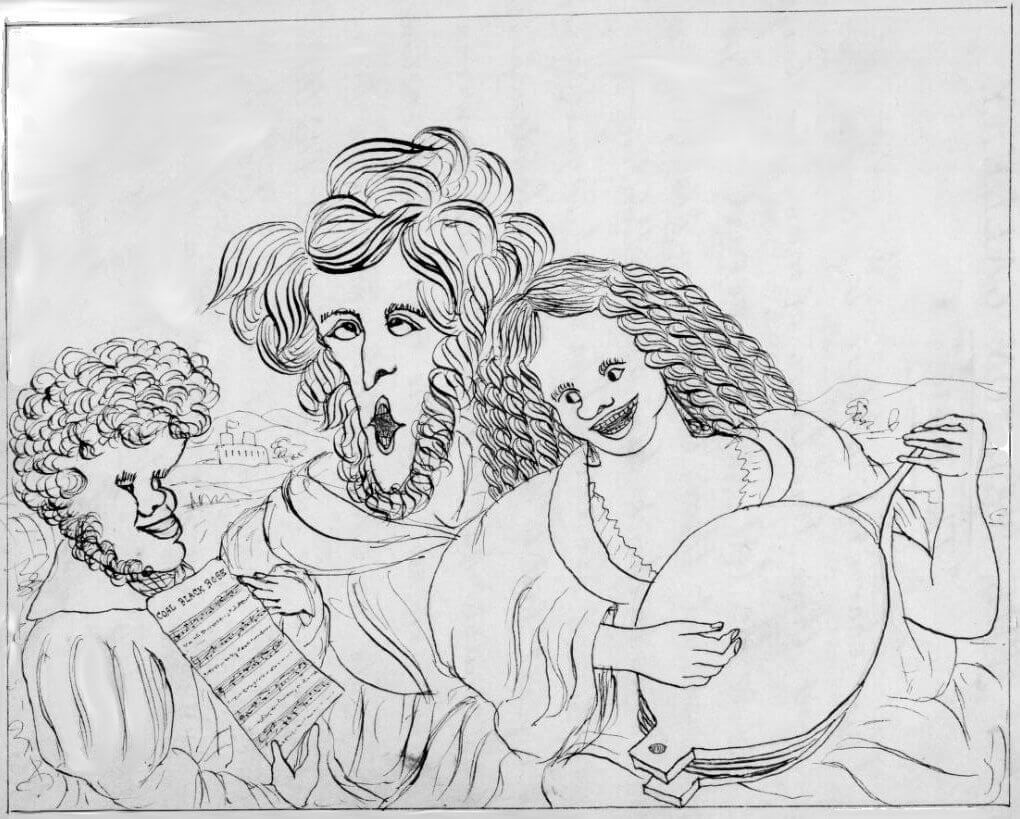
The Duett.
from the picture in the Vernom Gallery.
This charming picture is intended to represent three true lovers of music; for though the boy on the left is taking no part in the performance, yet there is a fire in his eye which forbids us to think him an inattentive or unadmiring listener. The most casual observer cannot fail to remark what a tendency the love of music has to make the hair grow in full luxuriance, nay, he may safely conclude, if he finds no such effect produced in him, that he has no ear for melody. A further proof of the lady’s great musical taste is that she is producing the most mellow strains from a pair of common kitchen bellows13: the song they are singing my readers have no doubt often heard.
- perhaps an incorrect expression, as it was only the second attempt. ↩
- the science of taking medicine in infinitely small doses. ↩
- ↩
“Some mute inglorious Milton here may rest,
“Some Cromwell, guiltless of his country’s blood.”Gray’s Elegy.
↩- a man’s history of his own life. ↩
- the author of “the Bandy-legged Butterfly.” ↩
- afterwards President of the Society for the prevention of Cruelty to Animals. ↩
- or a pulling by the ear. ↩
- the word “walk” implies the use of more legs than one. The only way it could possibly advance would be hopping. ↩
- viz. by the hair. ↩
- i. e. expressing exquisite pain. ↩
- probably Lemon Pippins. ↩
- this, in point of fact, is the only instrument by means of which a brisk air can be produced. It’s use requires a strict attention to the bars. ↩